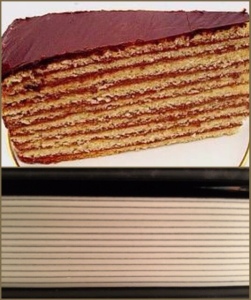- Winner of the Helen and Kurt Wolff Prize 2021
- Translated from German by Jackie Smith
Flippant first impression: This is the bookish equivalent of a Prinzregententorte! Just compare the sideviews.*

The cake is constructed with thin sponge layers separated by chocolate buttercream. It is then covered in a dark chocolate ganache. Great skill is required to construct a Prinzregententorte as the sponge layers must be equal in height. And so to Schalanksy’s book: 12 sections, 16 pages long (sponge), each fronted with a black sheet featuring a faint image of the subject of the section (chocolate buttercream), bound in black (dark chocolate) covers. Schalanksy designs her own books. Was she thinking of the Prinzregententorte when she designed this? I doubt it. The Prinzregententorte is a Bavarian confection, and Schalansky hails from the North-East of Germany. Hopefully she’ll forgive me the comparison. The point is though that much care, skill and discipline went into constructing her book …

… and knowledge. Only a couple of pages into the foreword with its inventory of things lost and found while she was writing the book, I was in awe. How on earth has she researched all this, I was thinking? Then in the very first chapter, assuming the narrator is herself, she told me:
I was leading the life of a home-dweller, of a library frequenter, permanently on the lookout for new research subjects to shed light on some hidden source of my existence and lend some kind of meaning to my life by the semblance of a regular daily work routine.
So a restless mind, with countless interests and limitless curiosity, which is certainly reflected in the contents. The text of each chapter begins with a italicised explanation of the object lost before jumping to Schalansky’s – ah, what shall I call them – essays, memoirs, stories? The dividing line between fact and fiction isn’t always clear, and sometimes the connection between the lost item and the accompanying text is quite tangential. Which led occasionally to a feeling I really don’t like – losing my bearings, not knowing where I am or who is narrating. Most of the time this didn’t happen, and certainly not in my favourite pieces. With starting points for her pieces ranging from sunken islands, extinct animals, buildings and paintings destroyed by fire, literature and other objets d’art destroyed by human hand, each reader will have their favourites. These are mine:
#2 based on the extinct Caspian tiger in which Schalansky reconstructs a fight in a Roman amphitheatre between a tiger and a lion.
#5 starts with Friedrich Wilhelm Murnau’s lost film based on Thomas Gainsborough’s painting “The Blue Boy”. Schalanksy then switches to the fictionalised thoughts of Greta Garbo, a actress lost to the world by her own choice, as she walks through New York City.
#9 features another painting and another walk. Caspar David Friedrich’s painting of Greifswald Harbour was lost in the fire at the Munich Glass Palace in 1931. In walking along the River Eyck from its source to Greifswald Harbour, the narrator – Schalansky herself? – describes the landscape and possibly evokes the mood of the lost painting. As Greifswald is one of my bucket list German destinations, specifically because of the Friedrich connection, this piece certainly had me longing to travel again.
It also had me wondering about the challenge of translation. All that flora and fauna and specialist vocabulary. The varying styles, all of which are rendered into English with panache by Jackie Smith, though I reckon not without much consultation of the dictionary and other reference works. An Inventory of Losses is a deserving winner of the 2021 Helen and Kurt Wolff Prize.
* Cake photograph from alchetron.com
I haven’t read this yet but I immediately got out my copy to check the Prinzregententorte reference – LOVE IT!
We call that Dobostorte in Romania (a Hungarian name though, so I suspect the Austro-Hungarian Empire was not unanimous in the name of this cake). I was never any good at it, but my aunt was brilliant, needless to say!
Well shoot. I really enjoyed the preface / introduction etc but when we finally got into the book itself, I couldn’t get interested in it.
I agree the preface is genius. The other pieces are indeed a mixed bag, some really chiming with me, others not so much. I suppose it depends on your personal interests.